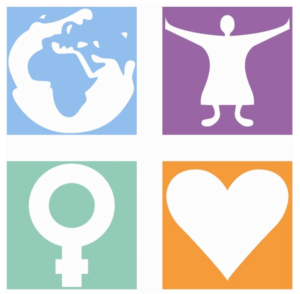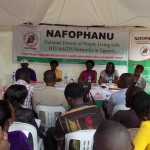We are celebrating the promising results of the Phase III efficacy trial of two studies ASPIRE and The Ring Study which just confirmed that a vaginal ring can safely and effectively help prevent HIV infection in women.
About the dapivirine ring
The product is fitted inside the vagina where it releases anti-retroviral medication (dapivirine) slowly over a period of one month to prevent HIV infection among HIV negative women.
The vaginal ring offers discreet and long-acting protection against HIV infection among women. It is convenient and easy to use, which may help ensure that women use it consistently, and discreetly if they choose to. The vaginal ring also has the potential to deliver combinations of an anti-retroviral drug along with a contraceptive, which would allow women to preserve their HIV prevention and reproductive choices. It is one of the biggest breakthroughs in HIV prevention.
As we wait the ring’s approval, AIDS continues to be the leading cause of death for women of reproductive age (15-44). This is due to the biological make up of the female genital tract and cultural factors such as forced and early marriages, rape, widow inheritance, polygamy and gender based violence; women are more likely to be infected with HIV than men.
In fact, women account for more than half of the world’s population living with HIV. In Sub Saharan Africa where unprotected heterosexual sex is the primary driver of the epidemic, nearly 60 percent of adults with HIV in are women especially young women aged 15-24 years.
But there are no practical tools that women can use discreetly to protect themselves against HIV. All existing HIV prevention methods such as the condoms (including the female condom), abstinence, fidelity and safe male circumcision require male partners’ cooperation and involvement, which is not always guaranteed.
Way forward
This is what makes the dapivirine vaginal ring very important to women and girls. Global efforts should now be directed towards speeding up its licensure and making the product affordable and available to all women, especially those at an increased risk of HIV infection like young women, adolescent girls and sex workers. There should also be additional investment in research to see to it that the safety and efficacy levels of the ring in girls below 21 years can also be increased.
In the interim, Governments with a high HIV burden like Uganda should take on additional tools and approaches that have already been found to be safe and effective in HIV prevention.
About PrEP
Late last year, World Health Organization (WHO) released guidelines, which recommend the use of oral pre-exposure prophylaxes (PrEP) to prevent HIV infection in populations at risk. PrEP is the use of antiretroviral drugs to prevent HIV infection, with Truvada being the drug that has been proved to be more effective in stopping HIV infection. By taking PrEP daily, the presence of the medicine in one’s bloodstream can often stop HIV from taking hold and spreading. Several studies of PrEP have shown that the risk of getting HIV infection was about 92 percent lower for those who took the medicines consistently than for those who didn’t take the medicines. This means vulnerable groups such as women and adolescent girls can benefit from PrEP to reduce HIV infections. But this requires the Governments to adopt and implement these guidelines in order to pave way for the use of PrEP in their respective countries.
Recommendations
Efforts must also be made to scale-up access to anti retroviral treatment for people living with HIV, which can significantly suppress or keep the HIV viral load low and therefore minimize women acquiring HIV from their partners. WHO’s 2015 guidelines on HIV treatment recommend that all people living with HIV be started on HIV treatment as soon the HIV test confirms their status. These Guidelines came after results from the START trial, which provided conclusive evidence of the benefits of immediate initiation on treatment after a confirmatory test. This means that all people living with HIV in Uganda must be on treatment. Initiating and staying on treatment keeps the viral load of people living with HIV below a threshold that is detectable with laboratory tests can help prevent HIV transmission. This could reduce the overall community viral load and have a population-level impact on HIV transmission.
Ultimately, these approaches require health systems’ strengthening to address barriers to healthcare access by women and young girls. Women who might use the vaginal ring or PrEP are required to undertake regular HIV testing and counseling because those who sero-convert should be taken off the medication or the vaginal ring immediately. In addition, people can only enroll for PrEP or the use the vaginal ring after tests have confirmed that they are HIV negative. Viral load monitoring should be stepped up and made accessible to all people living with HIV. There must be a pragmatic approach of integrating HIV prevention into broader sexual reproductive health services in the public health sector. These services must be women and youth friendly
Besides direct HIV prevention approaches, Governments must address socio-cultural drivers of HIV infection among women and young girls such as early and forced marriages, rape, widow inheritance domestic violence and unemployment. Young girls must be kept longer at school because educated girls and women are likely to make more informed choices about their sexual and reproductive health. They are also more likely to know how HIV is transmitted and prevented and the benefit of staying on treatment if they are living with HIV.
Because women carry the heaviest burden of the HIV epidemic, they must be put at the centre of policy formulation and programming if we are to realize an HIV and AIDS free era. Female-initiated prevention products offer new hope in the fight against HIV because they empower women to protect themselves at any time and in turn their children, sexual partners and communities.
Rachel Nandelenga
Sexual Reproductive Health Officer, ICWEA
NB: A version of this opinion was also published in Uganda’s Leading newspaper New Vision: http://www.newvision.co.ug/new_vision/news/1418913/war-hiv-focusing-women-girls



